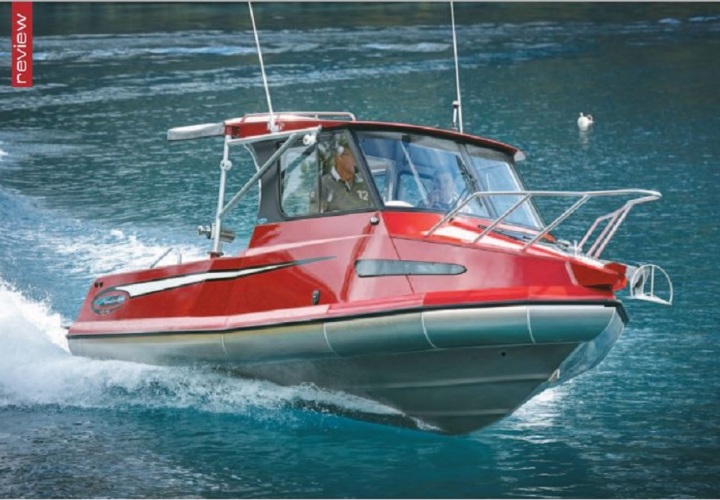While Kiwi-Kraft has been the well known brand name of rigid pontoon alloy boat builder Kiwi Engineering & Marine Ltd for 25 years, it was only when Rodney Harris, managing director and founder, saw a need for a strategy to break into the Australian market that the Aqualine brand was introduced. “Selling a boat in Australia with the name Kiwi doesn’t go over well with a lot of Australian buyers, so we thought the easiest thing to do was to change the name to something more generic”, said Harris. The Aqualine range is identical to Kiwi-Kraft, except for a number of new models introduced recently. It is a move that has certainly paid off, with sales to Australia over recent years steady and increasing. “Our market is quite broad and even includes an 11m custom boat to Darwin, plus quite a number of smaller boats sold in North Queensland and Victoria”, added Harris.
However, it seems that Aqualine boats are not just destined for Australia anymore, as the company has appointed a sole North Island dealer, Boat City Paraparaumu, and now sells the brand direct from its factory in Invercargill. Harris has stated that he has no intention of becoming a mass producer of boats – he enjoys the one-on-one interaction with his dealers and boat owners that small-scale production allows. This also leads to a high level of customisation and as he often says, “If you can dream it we can build it.”
Wonderful Wakatipu
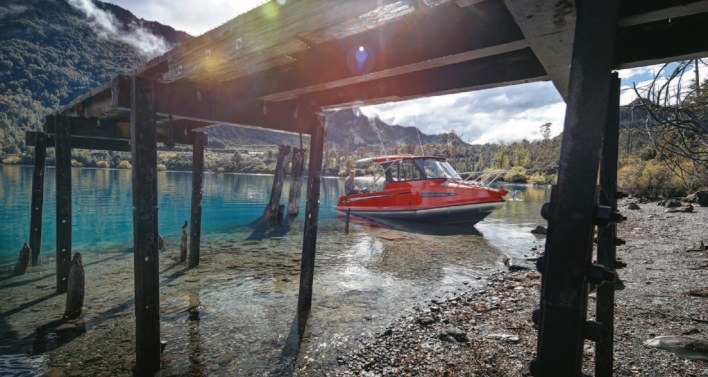
There’s probably no more beautiful and picturesque a venue to test a boat than Queenstown’s Lake Wakatipu. It is some time since I have been on the lake and its appeal for me is undiminished. Although it was raining heavily when I arrived, the old adage of “two seasons in one day” played true, with brilliant sunshine breaking through the grey clouds on various occasions. Fortunately, we were able to get some great photos in Bob’s Cove.
The cove was a campsite for Maori on the greenstone / pounamu trail to the head of the lake. In the 1870s, seven lime kilns were built there to burn limestone for building mortar and agricultural fertilizer and a very derelict wharf, which we used for our photo shoot, still remains. One intact kiln can still be seen alongside the track.
Testing the boat on the mirror smooth waters of Lake Wakatipu didn’t give me any indication as to how the boat would perform in the rougher water. However, from my past experiences with Kiwi-Kraft boats and talking to owners of similar sized Kiwi Kraft boats, the ride and performance in moderate to rough water is exceptional.
The underwater hull shape is very traditional, with a fine entry, 20° deep V at the transom and two strakes either side. There is the added benefit of very wide tubes that act not only as stabilisers, but trap air and provide both extra lift and softness of ride.
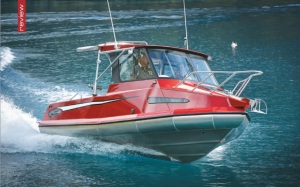
Kiwi Engineering uses its own aluminium boat technology, called Kiwi Hushtec, that incorporates a variable deadrise hull coupled to the cushioning pontoons. This, according to Rodney Harris, is to increase straightline speed and improve manoeuvrability and all-round handling in any conditions.
Diesel Do
The Aqualine 645 is available in single or twin outboard, or single diesel or petrol sterndrive or waterjet. Our test boat was the first with a MerCruiser Diesel TDI 3-litre V6, a 265hp common rail diesel engine that is a mini power house. I have now tested a few boats with the TDI V6 and what a great little engine it is. It’s compact, runs smoothly and provides a solid power curve right through the rpm range. What’s nice about the V6 configuration is that it compacts nicely into the rear of the cockpit and the engine box is far from obtrusive. It doubles generally as another seat or is also great as a bait prep area.
It was interesting that on the mirror smooth water, with the throttle wide open and the rev counter touching 4200 rpm, the speedo hovered around 38.5 knots. On the way back to Frankton Arm after our photo shoot in Bob’s Cove, with 10 knots of breeze right on the bow and a very slight ‘jobble’ on the lake surface, the speed increased to closer to 40 knots for the same rpm. Clear indication of how the air entrapment works to provide extra lift.
I was very impressed with the quick acceleration from an idle speed start, and you really feel the ‘kick’ when the turbo comes in at around 2000 rpm. The 645 runs from 0 to 15knots and on the plane in just a touch over 5 seconds. A nice cruising speed on the lake was almost 28 knots @3000rpm, with the TDI 3-litre using 28L/h for just on 1.0L/NM.
At wide open throttle, fuel consumption is 55L/h for 1.41L/NM and at the other end of the scale, at 1000 rpm @ 7.5 knots, the TDI was dribbling through 2.3L/h for 0.32L/NM. Given that the Aqualine 645 comes standard with a 260-litre fuel tank, that relates to a trolling range of around 720NM and cruising range of 233NM, both allowing for a 10% reserve.
Cosy Interior
When you see the optional pot hauler on the side of the boat it’s reasonably safe to assume that the owner is into his fishing/diving and that the layout would reflect that. However, while there are obvious signs of a serious fishing machine, the cabin and wheelhouse area has been finished to a high standard of comfort and one would expect that staying away overnight wouldn’t be a hardship.
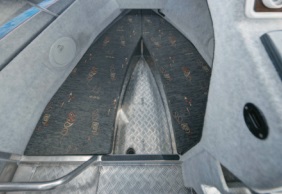
Forward is the large cabin with the standard single berths either side, with a cushion infill to form one large double.
There’s storage under the squabs, in side trays and in covered side pockets built into the pontoons. The cabin is all lined in a soft grey fabric so apart from the chequer-plate sole and squab bases, there is no alloy panelling visible. You could always cover this with carpet if you wished. Overhead, a large deck hatch allows some access to the foredeck, but also provides a natural air flow and light for the cabin. Should any water find its way into this area, the cabin sole is self draining.
There’s a bulkhead to starboard for the helm, but the layout is completely open to port so the flow though is uninterrupted and blends the two areas together well. The wheelhouse in our boat was complete with a rear opening door, but you do have the choice of leaving this completely open.
The wheelhouse seating is reasonably simple with a pair of single swivelling buckets on storage bases. However, you can really change things around here and add a galley unit and even a small fridge if you want more overnighting functions built-in.
I liked the look of the white instrument cluster and diagnostic panel on the raised facia and the positioning of the Lowrance HDS8 GPS/plotter. Overhead there was a GME VHF. The driving position is fine either seated or standing, with more than enough headroom for taller boaters. Auto anchor allows you to do all the anchoring tasks from the comfort of the wheelhouse. Sliding side windows let in extra ventilation.
Let’s Fish
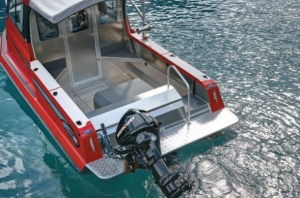
The 1.72m cockpit is plenty large enough to fish four people without getting in each other’s way. The overhead soft bimini slides out over the forward area of the cockpit when you are looking for some shade or weather protection and slides back out of the way if you’ve got some serious fishing going on.
The standard package includes five deck-mounted rod holders in the wide, flat coamings, a full-width boarding platform with telescopic ladder and auxiliary outboard bracket and step-through transom with drop-down door and conveniently placed handrail. There are a couple of small auxiliary seats forward and the engine box also doubles as a great seating space.

Storage shelves either side take care of a lot of your fishing gear, plus there is limited storage in the transom, either side of the engine box. Again, this is a space that you can personalise with things like a live bait tanks and extra seating. Under the chequer plate sole is a 260-litre fuel tank and an optional kill tank.
Getting It Right
No matter what you want to call it, Kiwi Kraft or Aqualine, the 645 is a great boat for anyone looking for a rigid pontoon boat of this size. Designer Rodney Harris has certainly got it right with the 645 and I especially liked the intelligent layout and overall finish of the boat. As one of New Zealand’s longest established builders of pontoon boats, Harris and his team certainly know what they are doing and their Aqualine 645 is a perfect example of their workmanship.
Plus the bonus of an alloy boat like this, is if you want to change something from the standard layout to suit your needs, then it can be done a lot easier and much less expensively than with a stock GRP boat. Plus, I think you will agree, when photographed in the right light in the right location by an internationally recognised photographer, it’s a damn good looking boat as well.


